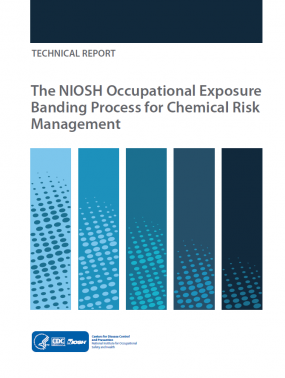The NIOSH Occupational Exposure Banding Process for Chemical Risk Management
July 2019
DHHS (NIOSH) Publication Number 2019-132

Occupational exposure limits (OELs) play a critical role in protecting workers and emergency response personnel from exposure to dangerous concentrations of hazardous materials [Cook 1987; Deveau et al. 2015; Paustenbach 1998; Nikfar and Malekirad 2014; Schulte et al. 2010; Skowroń and Czerczak 2015]. In the absence of an OEL, determining the appropriate controls needed to protect workers from chemical exposures can be challenging. According to the U.S. Environmental Protection Agency (US EPA), the Toxic Substances Control Act (TSCA) Chemical Substance Inventory currently contains over 85,000 chemicals that are commercially available [US EPA 2015], yet only about 1,000 of these have been assigned an authoritative (government, consensus, or peer reviewed) OEL. Furthermore, the rate at which new chemical substances are being introduced into commerce significantly outpaces OEL development, creating a need for guidance on thousands of chemical substances that lack reliable exposure limits [OSHA 2014].
Occupational exposure banding, also known as hazard banding or health hazard banding, is a systematic process that uses qualitative and quantitative hazard information on selected health-effect endpoints to identify potential exposure ranges or categories. The National Institute for Occupational Safety and Health (NIOSH) occupational exposure banding process seeks to create a consistent and documented process with a decision logic to characterize chemical hazards so that timely, well-informed risk management decisions can be made for chemical substances that lack OELs. Users can band a chemical manually or by using the occupational exposure banding e-Tool. Overall, this document provides the background, rationale, and instructions for the occupational exposure banding process and gives guidance for risk managers to identify control levels for chemicals without authoritative OELs.
The NIOSH Occupational Exposure Banding Process for Chemical Risk Management [PDF – 3 MB]
Suggested Citation
NIOSH [2019]. Technical report: The NIOSH occupational exposure banding process for chemical risk management. By Lentz TJ, Seaton M, Rane P, Gilbert SJ, McKernan LT, Whittaker C. Cincinnati, OH: U.S. Department of Health and Human Services, Centers for Disease Control and Prevention, National Institute for Occupational Safety and Health, DHHS (NIOSH) Publication No. 2019-132, https://doi.org/10.26616/NIOSHPUB2019132
